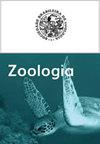Age, growth and reproductive biology of two endemic demersal bycatch elasmobranchs: Trygonorrhina fasciata and Dentiraja australis (Chondrichthyes: Rhinopristiformes, Rajiformes) from Eastern Australia
IF 1.8
4区 生物学
Q4 ZOOLOGY
引用次数: 2
Abstract
Bottom-dwelling elasmobranchs, such as guitarfishes, skates and stingrays are highly susceptible species to bycatch due to the overlap between their distribution and area of fishing operations. Catch data for this group is also often merged in generic categories preventing species-specific assessments. Along the east coast of Australia, the Eastern Fiddler Ray, Trygonorrhina fasciata (Muller & Henle, 1841), and the Sydney Skate, Dentiraja australis (Macleay, 1884), are common components of bycatch yet there is little information about their age, growth and reproductive timing, making impact assessment difficult. In this study the age and growth (from vertebral bands) as well as reproductive parameters of these two species are estimated and reported based on 171 specimens of Eastern Fiddler Rays (100 females and 71 males) and 81 Sydney Skates (47 females and 34 males). Based on von Bertalanffy growth curve fits, Eastern Fiddler Rays grew to larger sizes than Sydney Skate but did so more slowly (ray: L∞ = 109.61, t0 = 0.26 and K = 0.20; skate: L∞ = 51.95, t0 = -0.99 and K = 0.34 [both sexes combined]). Both species had higher liver weight ratios (HSI) during austral summer. Gonadal weight ratios (GSI) were higher in the austral winter for Eastern Fiddler and in the austral spring for Sydney Skates.东澳大利亚两种地方性底栖副渔获物:板形拟淋鼻虫和澳洲牙鼠的年龄、生长和生殖生物学
生活在海底的弹鳐、鳐和黄貂鱼是极易受副渔获物影响的物种,因为它们的分布与捕鱼作业区域重叠。这一群体的捕获量数据也经常被合并为一般类别,从而无法对特定物种进行评估。在澳大利亚东海岸,东部提琴鳐,Trygonorrhina fasciata (Muller & Henle, 1841)和悉尼鳐,Dentiraja australis (Macleay, 1884)是副渔获物的常见组成部分,但关于它们的年龄、生长和繁殖时间的信息很少,这使得影响评估变得困难。本研究以171条东方提琴鳐(100条雌性和71条雄性)和81条悉尼溜冰鳐(47条雌性和34条雄性)的标本为基础,对这两个物种的年龄、生长(来自椎带)以及生殖参数进行了估计和报告。根据von Bertalanffy生长曲线拟合,东方提琴鳐比悉尼鳐长得更大,但生长速度更慢(射线:L∞= 109.61,t0 = 0.26, K = 0.20;滑冰:L∞= 51.95,t0 = -0.99, K = 0.34[男女合计])。在南方夏季,两种鱼的肝重比(HSI)均较高。在南方冬季,东部提琴手的性腺重量比(GSI)较高,而在南方春季,悉尼溜冰者的性腺重量比(GSI)较高。
本文章由计算机程序翻译,如有差异,请以英文原文为准。
求助全文
约1分钟内获得全文
求助全文
来源期刊

Zoologia
生物-动物学
自引率
0.00%
发文量
15
期刊介绍:
Zoologia, the scientific journal of the Sociedade Brasileira de Zoologia (SBZ), is an international peer-reviewed, open-access Zoological journal that publishes original research on systematics, evolution, taxonomy, nomenclature, biogeography, morphology, physiology, biology, ecology, symbiosis, conservation, behavior, genetics and allied fields. The journal, formerly known as Revista Brasileira de Zoologia, publishes original articles authored by both members and non-members of the Society. The manuscripts should be written exclusively in English.
 求助内容:
求助内容: 应助结果提醒方式:
应助结果提醒方式:


